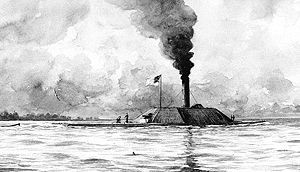This article includes a list of general references, but it lacks sufficient corresponding inline citations. (August 2012) |
 A drawing of Albemarle
| |
| History | |
|---|---|
| Name | Albemarle |
| Namesake | Albemarle Sound |
| Ordered | 16 April 1862 |
| Laid down | January 1863 |
| Commissioned | 17 April 1864 |
| Fate | 27 October 1864 sunk by spar torpedo, captured, raised, and sold |
| General characteristics | |
| Displacement | 376 tons |
| Length | 158 ft (48 m) |
| Beam | 35.4 ft (10.8 m) |
| Draught | 9 ft (2.7 m) |
| Propulsion | Steam |
| Speed | 4 knots (7.4 km/h; 4.6 mph) |
| Range | 120 miles, 193 km |
| Complement | 150 officers and men |
| Armament | two 6.4 Brooke double-banded rifles |
CSS Albemarle was a steam-powered casemate ironclad ram of the Confederate Navy (and later the second Albemarle of the United States Navy), named for an estuary in North Carolina which was named for General George Monck, the first Duke of Albemarle and one of the original Carolina Lords Proprietor.